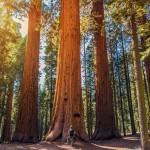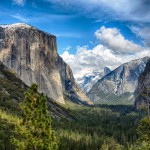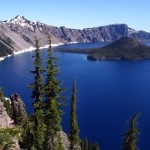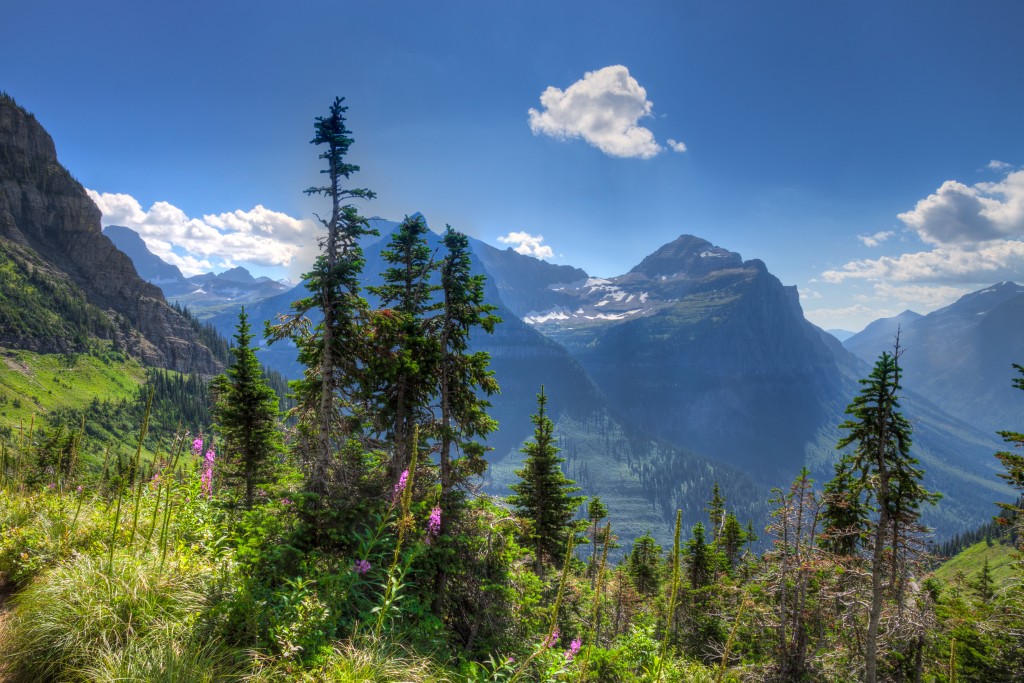Yellowstone - America's First National Park
Yellowstone National Park is over two million acres of natural landscape – mostly woodland – crossing three states. The overwhelming majority of the park, some 96%, is in Wyoming but it also crosses into the borders of Idaho and Montana. It was the first of many National Parks to be created in the USA and today is a UNESCO World Heritage site that receives millions of visitors every year from all over the world (1).
It is an important nature reserve for plants and animals, but it is also important to geologists, helping us understand how geological processes affects and interacts with ecosystems. Yellowstone has the world’s largest concentration of geysers and is the site of the world’s largest supervolcano. They differ from regular volcanoes in that magma sits under the surface, unable to break through the crust. Therefore they do not look like conventional volcanoes; their ejection mass is much larger too – over 1000km3 in a typical eruption (2).
Yellowstone is considered a virgin landscape, one of only a few anywhere in the northern hemisphere (1) and in that, it is even more important to researchers. For those wishing to enter into the conservation field and as a park ranger, it is of particular interest because of the unique challenges it presents. Yellowstone is a UNESCO listed heritage site for the the large number of rare plant and animal species that are found within the park.
History of Yellowstone National Park
Evidence suggests that Yellowstone has been occupied for some 10,000 years – perhaps longer as archaeological study of the park is poorly understood and problematic due to the highly acidic nature of the soil making survival of remains – especially human bones – unlikely in most cases (3, p213). Nevertheless, anthropologists and archaeologists have built up enough of a picture to understand the early human history of the area. There is a particular distinct lack of arrowheads and other stone tools today but documentary evidence from the 19th and early 20th century suggest these were commonly found in the area at one time (3, p214). Archaeology now plays a big part in drawing visitors to Yellowstone and there are programs and tours that encourage and educate people about its early prehistory (5).
Modern interest in the Yellowstone area began in the 18th century when a British fur trader first penned the term “Yellow Stone” after visiting some local villages; it is not known whether he visited the main areas of what today is the main park area (4). The early 19th century was the golden age of exploration of Yellowstone and public interest grew; the Lewis and Clark Expedition got the first indicators that there was a large volcano in the area but it wouldn’t be until late in the century, around 1870, that there would be an organised expedition (5). One had been planned many years before, but the Civil War put this one hold.
Public perception and interest in the area must have really captured the imagination as it was declared a National Park in 1872. Signed into law by President Ulysses Grant, it was notable in that it was not only the first National Park in the country, but also in the world. It introduced the concept of a need to protect natural or semi natural environments from exploitation and for it to be “set apart as a public park or pleasuring ground for the benefit and enjoyment of the people” (4). Over the following decades, many presidents visited the site to draw attention to the natural wonder.
The arrival of the railroad and the building of several key hotels within the park’s boundaries meant a boost for tourism that the park continues to enjoy today. The 1950s to 1970s saw a number of new measures and laws designed to protect the wildlife of the park. There had been ongoing problems with poaching that needed to be controlled. It had for many years until that point been a major popular centre of recreation – hiking and water sports. In the 1970s, though it still is used for leisure, people became far concerned with conservation (6) in line with a general interest in environmentalism and protecting the natural world. Yellowstone became a biosphere reserve in the 1970s and once again, measures were putting in place to protect local wildlife. This time, fishing was prohibited in order to protect native species that were now seemingly under threat.
The Flora of Yellowstone
The plant life of Yellowstone is a mix of native Rocky Mountain flora from the west and Great Plain species from the east (7), though Rocky Mountain species are more common, particularly on the north rim. Typical species include marsh marigold, wild strawberry, glacier lily, prickly pear and more that are typical of the temperate zone (8). Many are seasonal, blooming in the summer months – visit Yellowstone between May and October and you are likely to see the most common plants.
One particular plant found only in the park is the Yellowstone sand verbena (10). It is considered particularly enigmatic because it is most closely related to the sand verbena found in much warmer areas of the US. It has evolved itself into a niche along the edges of the lake and therefore has protected status within the park because of its peculiar adaptation to colder weather. It has been theorised that the Yellowstone sand verbena colonised because of the warm nature of the soil and eventually evolved resilience to winter frost.
Tree species are as varied as smaller plants and visitors will see many species common to the region. There are no fewer than eight types of conifer including three types of pine, three types of fir and deciduous species such as aspen and cottonwood (7) – though these latter two had been in decline until relatively recently. Overall, Yellowstone has an astounding number of tree species – something like 1700. The park is an important resources for botanists, foresters and conservationists the world over.
Flora Conservation Issues
There are 218 species of non-native plants (7); in many areas of the world, invasive species can be difficult to maintain and disastrous when they get out of control. Park Rangers and conservationists who work within Yellowstone understand the need to strike the balance between letting nature take its course and not permitting native species to be threatened by invasive species.
During the 20th century, the number of new growths of aspen trees was in serious decline. This was largely attributed to a growth in elk population fuelled by a reduction in wolf population (9). This was confirmed in the early part of the 21st century when wolves were reintroduced in the park. The issue was that as elk are natural prey to local wolf species, elk populations began to decline, leading to a resurgence of new aspen growths and greater survival of young saplings that are now under less stress from elk browsing. The reintroduction of natural predators to Yellowstone is expected to have greater knock on effects for plants species and the evidence for local plant extinctions being related to extermination of wolves is compelling. National Park authorities elsewhere are expected to use this measure to protect and encourage native plant species that may have been under threat from foraging and herbivore browsing.
Community development is strictly regulated within National Parks but that does not mean that no building is permitted – new constructions are part of the lifeblood of the people who live within the park and development of new hotels and leisure facilities are good for tourism. This means that ahead of any new proposed building development conservationists must investigate whether there are any threatened or protected species in the area; samples are taken for survey in order to protect the integrity of the ecology of the park or an area within it (7).
The Fanua of Yellowstone
At the last glacial maximum, Yellowstone is known to have been home to large fauna including mammoth and giant bison (11). We also know from evidence that these species died off as the glaciers retreated and other species moved in, many of which we see there today. Yellowstone is incredibly rich in wildlife, some of which are threatened and others are common – working with the animals of the park presents some unique problems, particularly where there is competition for resources. Most common species include grizzly bears, bison, wolves (since their recent reintroduction) and wapiti – a type of elk native to North America.
There has been much valuable research into grizzly bears at Yellowstone and thanks to this intense study, this species is one of the most understood of all bear types (1). Thanks to protection programs, their numbers and range have increased in the last few years – from 136 in 1975 to around 800 in 2014. Grizzlies are now thriving and remain an important part of the park’s ecosystem (13).
Yellowstone is also the only place in the country where there has been a native population of bison since prehistory (12). For the last century, the population has been under 50 specimens and they are given protected status. The specimens at Yellowstone are a particular conservation success because it is the largest herd on public land and the only herd anywhere in the country not to have been interbred with cattle.
Fauna Conservation Issues
The positive reintroduction of wolves to Yellowstone means that bears and other predators now have more competition. Though bears are omnivorous, they do feed on the native ungulates of Yellowstone – a food source also valued by those reintroduced wolves (12). Though this is unlikely to affect the bear population greatly, later in the year when vegetation is much sparser and bears seek to increase their calorie intake before hibernating, this may have an effect in the long term as bears feed seasonally and primarily on carcasses abandoned by wolves and other predators. Despite the resurgence in numbers of grizzlies, they remain a threatened species (14).
The much prided bison herd has been subject to a number of health issues. Bison conservation is one of the most debated issues amongst experts in the US. Issues concerning the need for winter feeding grounds outside the park is largely one upon which most parties agree and several arrangements are in place. However, in the past, the herd has been diseased with brucellosis (Crimean Fever, Bang’s Disease) which is highly infectious; it can spread to elk and livestock (12), devastating ecosystems and commercial herds. It also affects human health though it generally works its way into the human population through unpasteurized milk and cheese and through under-cooked meat.
Ongoing Conservation Challenges
As we can see from the examples given above, conservation issues are rarely taken in isolation. The increase or decline of any species – be it animal or plant and no matter the size, can have a knock on effect for the wider ecology. The decline in wolves led to a decline in certain tree types for example and conservationists who work with waterways say that the changes wrought by the removal of wolves affected the ecosystem far more profoundly – it is believed that it led to significant erosion around the streams and rivers (9).
There are many species within the National Park boundaries that are not at risk or endangered but are in decline; the boreal toad is one example. It has been listed as threatened in Colorado and New Mexico and the main reason is believed to be a disease resulting from infection of the chytrid fungus (15); the situation is better at Yellowstone but numbers are seemingly in decline. The decline or loss of any species can upset delicate ecologies and sometimes, there are competing interests between the various authorities involved. Preserving one animal species and increasing their numbers can affect another type of animal or even affect the plant ecosystem.
Sources
(1) http://whc.unesco.org/en/list/28
(2) http://volcanoes.usgs.gov/volcanoes/yellowstone/yellowstone_sub_page_49.html#supervolcano
(3) http://www.nps.gov/yell/learn/nature/upload/speakerss_y.pdf
(4) http://yellowstone.net/history/
(5) http://www.nps.gov/yell/learn/historyculture/park-history.htm
(6) http://yellowstone.net/history/timeline/the-second-century-1972-present
(7) http://www.nps.gov/yell/learn/nature/plants.htm
(8) http://www.yellowstone.co/pdfs/wildflowers.pdf
(9) http://www.sciencedaily.com/releases/2007/07/070726150904.htm
(10) http://www.nps.gov/yell/learn/historyculture/earliest-humans.htm











